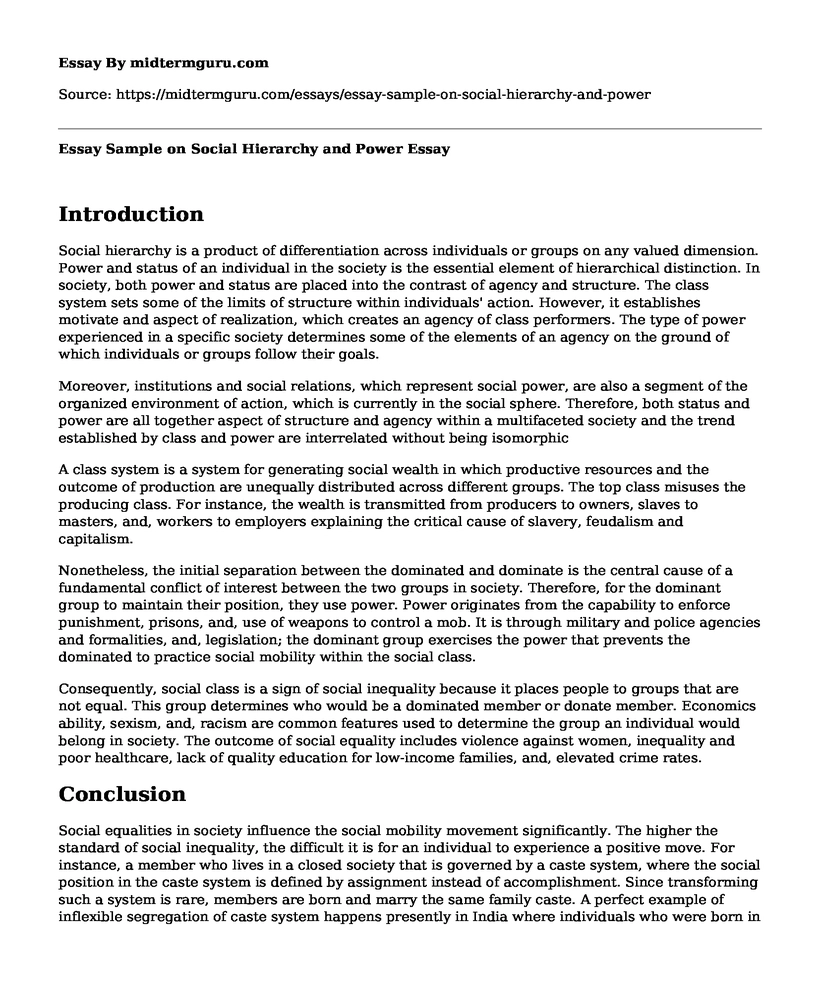Introduction
Social hierarchy is a product of differentiation across individuals or groups on any valued dimension. Power and status of an individual in the society is the essential element of hierarchical distinction. In society, both power and status are placed into the contrast of agency and structure. The class system sets some of the limits of structure within individuals' action. However, it establishes motivate and aspect of realization, which creates an agency of class performers. The type of power experienced in a specific society determines some of the elements of an agency on the ground of which individuals or groups follow their goals.
Moreover, institutions and social relations, which represent social power, are also a segment of the organized environment of action, which is currently in the social sphere. Therefore, both status and power are all together aspect of structure and agency within a multifaceted society and the trend established by class and power are interrelated without being isomorphic
A class system is a system for generating social wealth in which productive resources and the outcome of production are unequally distributed across different groups. The top class misuses the producing class. For instance, the wealth is transmitted from producers to owners, slaves to masters, and, workers to employers explaining the critical cause of slavery, feudalism and capitalism.
Nonetheless, the initial separation between the dominated and dominate is the central cause of a fundamental conflict of interest between the two groups in society. Therefore, for the dominant group to maintain their position, they use power. Power originates from the capability to enforce punishment, prisons, and, use of weapons to control a mob. It is through military and police agencies and formalities, and, legislation; the dominant group exercises the power that prevents the dominated to practice social mobility within the social class.
Consequently, social class is a sign of social inequality because it places people to groups that are not equal. This group determines who would be a dominated member or donate member. Economics ability, sexism, and, racism are common features used to determine the group an individual would belong in society. The outcome of social equality includes violence against women, inequality and poor healthcare, lack of quality education for low-income families, and, elevated crime rates.
Conclusion
Social equalities in society influence the social mobility movement significantly. The higher the standard of social inequality, the difficult it is for an individual to experience a positive move. For instance, a member who lives in a closed society that is governed by a caste system, where the social position in the caste system is defined by assignment instead of accomplishment. Since transforming such a system is rare, members are born and marry the same family caste. A perfect example of inflexible segregation of caste system happens presently in India where individuals who were born in the lowest rank can never become of a higher caste. South Africa also has a caste system. Besides, South Africa has a similar system.
On the other hand, an individual in an open society stands a chance to experience mobility is social class. The positions in class system rely more in an individual effort such as the level of education, rather than on ascribed status such as gender and race. Such an open system is found in a country such as America, where social inequalities are minimal. However, such as America has a free system. It is not a guarantee of a swift move into the next social class because other factors such as a child background play a huge role in defining a class an individual will belong to in the future.
Cite this page
Essay Sample on Social Hierarchy and Power. (2022, Sep 21). Retrieved from https://midtermguru.com/essays/essay-sample-on-social-hierarchy-and-power
If you are the original author of this essay and no longer wish to have it published on the midtermguru.com website, please click below to request its removal:
- Paper Example on South Asian American Communities
- Online Communication and its Impacts - Research Paper
- Organizational, Interpersonal, and Group Communication in Hospital - Essay Sample
- The Great Disparity: How Middle Class Perfect Was Manufactured - Essay Sample
- Equal and Fair Treatment: Cornerstone of the Workplace - Essay Sample
- Creating a Communication Plan for All Stakeholders - Essay Sample
- Single Parenting: A Challenging Yet Rewarding Journey - Essay Sample







